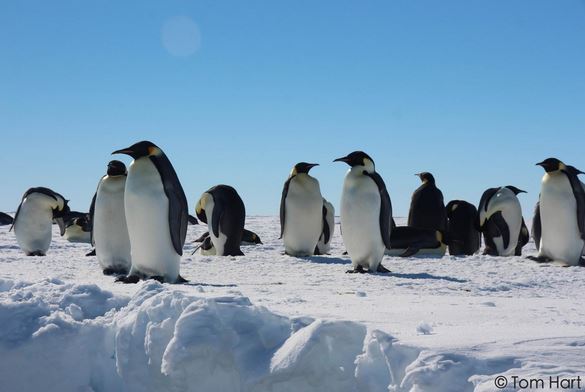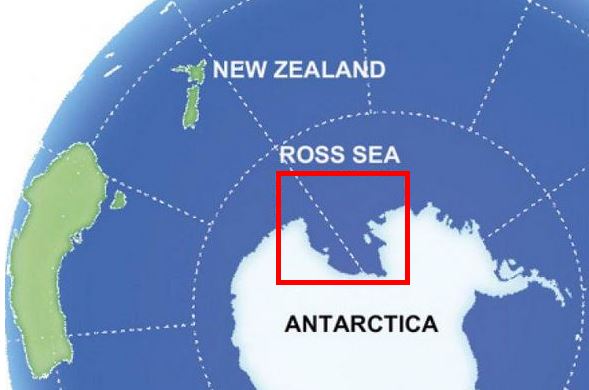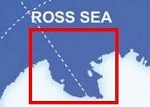In the last ice age, only three populations of emperor penguins are thought to have survived, one of them in the Ross Sea in Antarctica, which was a likely refuge, according to a study by Australian, American and British scientists.
The researchers, who looked at how climate change affected emperor penguins over the past 30,000 years, found that the Ross Sea was probably a shelter for them for thousands of years during the last ice age.
During the last ice age, from approximately 110,000 to 12,000 years ago, much of the rest of the continent had too much ice, making it uninhabitable.

A group of emperor penguins resting and preening next to a tide crack in the ice near the Gould Bay colony. (Credit Dr. Tom Hart)
The scientists, who published their findings in the academic journal Global Change Biology (citation below), suggest that climate conditions today are probably optimal for emperor penguins, conditions that were too extreme in the past for large populations to survive.
A team of scientists, led by researchers from the Universities of Southampton, Tasmania and Oxford, plus the Australian Antarctic Division, the Scripps Institution of Oceanography, and supported in Antarctica by Adventure Network International, studied the genetic diversity of ancient and modern emperor penguin populations in Antarctica to estimate how over time they had changed.
Emperor penguin designed for harsh conditions
The emperor penguin is well known for being able to adapt to its icy habitat, breeding in the sea ice during the Antarctic winter, where temperatures commonly plunge to below -30°C.
One of the lead authors, PhD student, Gemma Glucas, from Ocean and Earth Science at the University of Southampton, and colleagues discovered that conditions were likely far too harsh during the ice age for penguins, and that the populations was approximately one seventh of their present size, and split into three refugial groups.

Thanks to the Ross Sea, one population of emperor penguins managed to survive during the last Ice Age for thousands of years.
Mr. Glucas explained:
“Due to there being about twice as much sea ice during the last ice age, the penguins were unable to breed in more than a few locations around Antarctica. The distances from the open ocean, where the penguins feed, to the stable sea ice, where they breed, was probably too far.”
“The three populations that did manage to survive may have done so by breeding near to polynyas – areas of ocean that are kept free of sea ice by wind and currents.”
Ross Sea polyna helped penguins survive
A polynya located in the Ross Sea was likely to have been a key area that supported a population of emperor penguins throughout the ice age, the researchers believe.
They discovered that emperor penguins that breed in the Ross Sea today are genetically distinct from other emperor penguins in the continent.
Co-lead author, PhD student Jane Younger, from the Australian Institute for Marine and Antarctic Sciences, said:
“Our research suggests that the populations became isolated during the last ice age, pointing to the fact that the Ross Sea could have been an important refuge for emperor penguins and possibly other species too.”
Out of all the regions in Antarctica, the Ross Sea may be the last to be affected by climate change. Changes in wind patterns linked to climate change, in fact, have raised the extent of winter sea ice over the past few decades rather than reduced it, the scientists pointed out. This pattern, however, is forecast to reverse by the end of this century.
One of the organizers of the study, Dr. Tom Hart, from the University of Oxford, said:
“It is interesting that the Ross Sea emerges as a distinct population and a refuge for the species. It adds to the argument that the Ross Sea might need special protection.”
Citation: “Too much of a good thing: sea ice extent may have forced emperor penguins into refugia during the last glacial maximum,” Jane L. Younger, Gemma V. Clucas, Gerald Kooyman, Barbara Wienecke, Alex D. Rogers, Philip N. Trathan, Tom Hart and Karen J. Miller. Global Change Biology. Published online March 1, 2015. DOI: 10.1111/gcb.12882.

